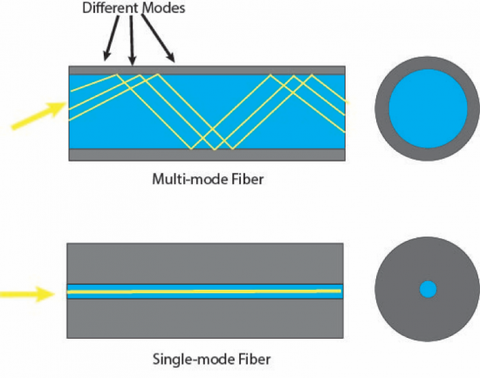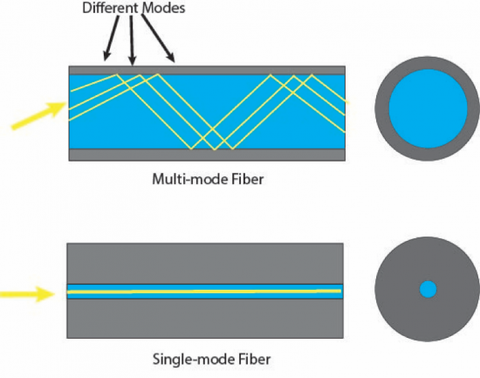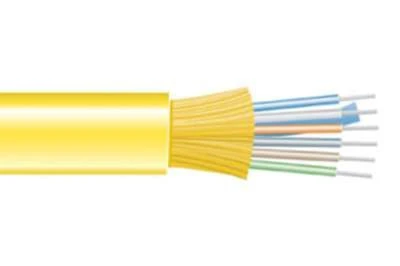As technology advances, there is a need to bring in a change in the wires too. Fiber optic cables are like copper cables. A copper wire system uses electronic pulses to send information. The optical cables use light pulses to do the same. It comprises a thin glass strand that works as a waveguide for long distances. With the demand for fast-paced technologies rising, fiber optic cables are replacing conventional copper cables. Fiber optic cables offer high speed and easy transmission of information and data.
Optical fiber is another common term of fiber optic cable. These cables have a large bandwidth capacity, high resistance, and need less maintenance. The pre-terminated fiber cable assemblies have two layers of glass, termed as (i) core layer (ii) cladding layer. The core glass layer carries the light signal. The cladding layer around the core prevents the light from escaping. The refractive index of the cladding is lower than the core. This ensures that the light, the internal reflection stays within the core. Apart from the core and cladding, there is another element in fiber optic cables, i.e., the coating, which helps preserve cables' strength. The coating can absorb shocks too.
There are three different types of fiber cables. Before we understand the types of fiber optic cables, let's take a look at their uses.
Uses of Fiber Optic Cables

(Image Source: Electrical4U)
Fiber optic cables have various applications like telecommunications, surveillance, and computer networking. Optical cables allow networks to send data at high speed. Many broadcasting industries use optical cables for CATV, HDTV, and other related applications. Optical fiber cables are also helpful for audio and video transmissions.
Optical cables help in the smooth functioning of network systems in industrial setups. Optical fibers offer a high lifespan and clear network transmission. Optical cables are lightweight, small-sized, and occupy less space in installation. Depending on fiber optic cable types, each of them has its own set of advantages.
Types of Fiber Optic Cables
The fiber optic cable types have been defined as
- Single-Mode Fiber (SMF)
- Multimode Fiber
- Plastic Fiber (POF)
Single-mode Fiber (SMF)
Single-mode fiber, as the name suggests, carries a single source of light in a straight line. The fiber has a diameter of 8.3 to 10 microns and transmits lights of 1310 to 1550nm wavelength. It has a high bandwidth and has uses in various applications. The transmission rate and speed of single-mode fibers are very high. It covers more than 50 times the distance in contrast to other fibers. The single wavelength fibers have a small core which removes distortion in signals. There is no overlapping of pulses in single-mode fiber cables, and it has less attenuation. Single-mode fibers have a high bandwidth which can send up to 100 GHz of data.

(Image Source: Cisco)
Multimode Fiber
The diameter of multimode fiber ranges between 50 to 100 microns. So, it can accept multiple light signals that travel across the phenomenon of light reflection. In multimode fiber optical cables, the transmission limit is about 2 km as they use shorter wavelengths of 1300 nm. Due to different reflection angles for each light signal, the time taken by each signal to reach the receiver is slightly altered. So, there is distortion after a specific length. Due to this, most users prefer single-mode fiber cables over multimode fiber cables for long-distance transmission.

(Image Source: Cisco)
Plastic Fiber
Plastic fiber cables have long wavelengths of fiber through which light carries signals. These cables transmit signals up to 10 meters and have low bandwidth. Most of the time, these are used for digital audio connections. These cables are cost-effective and are easy to connect with a minimalist use of tools.

(Image Source: HappyTTT)
Difference between Single Mode & Multimode Optic Cables
The primary difference between single-mode fiber cable and multimode fiber cable lies in its core. The size of the core in the single optical is narrow, and the multimode is wider. The color-coding on the outer jacket of single-mode cables is orange and aqua in the multimode cable jacket for differentiation.

(Single-Mode Fiber)

(Multimode Fiber)
Single-mode optic fiber has unlimited transmission length, and multimode is up to 2 km. Therefore, single-mode optic cables are used to cover large distances. Contrary to single-mode optic cables, multimode fiber cables cover shorter distances.
Conclusion
Most industries are switching to optical fibers, be it a telecom industry or a local cable television company. Fiber cables are in use at every place. Many universities and office setups use optical fiber cables for better LAN speed. Optical cables improve the data quality. The use of these cables is now making its way in many power utility companies as well. Compared to typical copper cables, optical fiber cables are less prone to obstruction. As a result, optical fiber cables are now the more preferred choice of consumers.







